What is a Genogram?
Part 1: What is a Genogram?
A genogram is a visual mapping tool that illustrates a person's family tree, relationships, and history. It is more than the traditional family tree giving insights into the medical history and behaviors of at least three generations of the family.
Genograms are very helpful, especially where physicians are concerned, as they help look into family dynamics, parentage, and birth order. Creating genograms is very effective for both the client and the physician as it helps the person understand their condition better and for the physician to prescribe effective therapies.
Part 2: History of Genogram
Genograms were first introduced in the 1970s as a part of the family systems model by Murray Bowen. It wasn't until Monica McGoldrick and Randy Gerson shed light on its importance in clinical settings. They published their book: "Genograms: Assessment and Intervention" in 1985 to show how genograms could deliver a wealth of information that will revolutionize the clinical world. Today genograms are actively used in the fields of medicine, social work, psychology, genealogy, research, and education.
Part 3: Where to Use a Genogram?
There is no one standard type of genogram used in all fields; rather, there are multiple of them used specifically for their purpose. Genograms serve mostly in clinical work, but they are also pretty popular in research and social work. Let’s look at a few places where genograms are popular:
1、Medical
A genogram is quite a useful tool, especially for doctors, while examining the patient history and history of disease in the family. Looking at hereditary diseases like down syndrome, autism, heart diseases, and a genogram is quite popular to help the patient at their earliest stages.
2、Education
Genograms are quite helpful in the education department. Medical students, especially doctors and nurses, can easily study patient history and diagnosis through genograms. While looking at multiple patients and their backgrounds, it is easier for them to understand their condition and treat them accordingly.
3、Psychotherapy
As the world has gradually realized the importance of mental well-being, genograms have become very useful in understanding the progression of mental illness in the family. More than that, it is an effective tool for understanding emotional relationships between individuals, especially those seeking personal or group therapy.
Part 4: Types of Genograms
Many types of genograms can be used depending on what you are looking for or researching. Here are a few types of genograms that are used frequently:
1. Family Genogram or Gender Genogram
A family genogram is the most popular of the bunch. It is quite basic, too, with its simple gender symbols connecting the family members. A family genogram at least shows three generations of the family, so it is quite useful for keeping a check on your family members, especially if your family has a complex structure. Family genograms are quite helpful for researchers to track back to a person’s parentage or ethnicity, especially if someone wants to know about their ancestors.
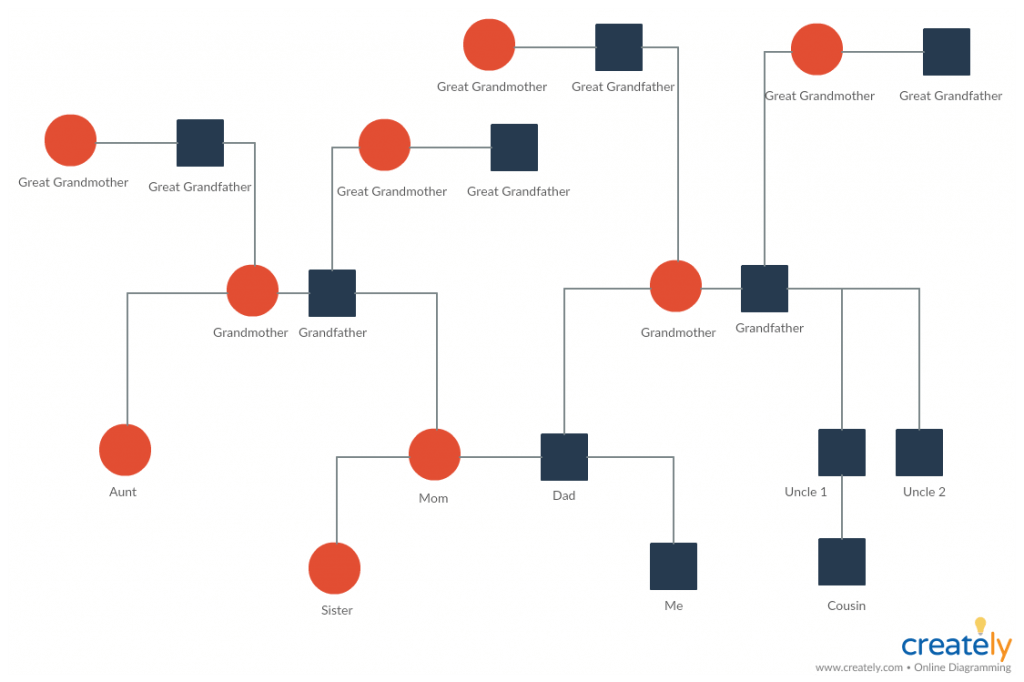
2. Emotional Genogram
An emotional genogram is a tool used by psychologists and therapists to understand the flow of emotions between different individuals of the family. It is quite helpful in therapies determining how everyone feels towards each other and their relationship. Some of the emotional relationships determined in this genogram include: conflicted, distant, very close, friendship. The genogram goes as far as identifying an abusive relationship, including mental, physical, and even sexual abuse.
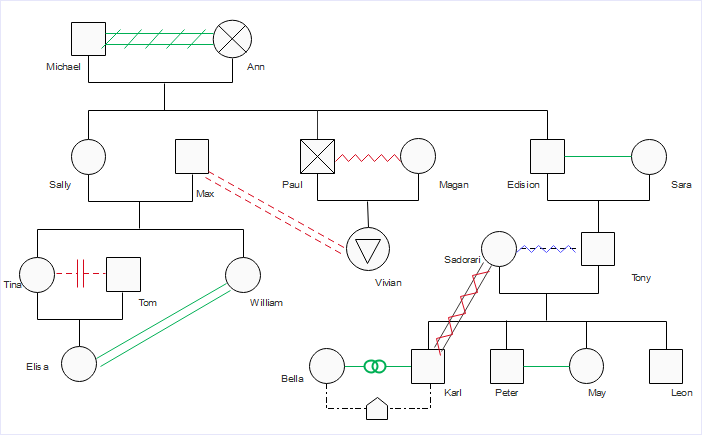
3. Relationship Genogram
While Emotional Genograms relate more towards individuals and their feelings towards each other, a Relationship Genogram determines how individuals are related to each other. The type of relationship is shown by varying the style of the line. The relationship genogram can represent marriage, a casual relationship, a committed relationship, or a temporary relationship. They also cover divorce, separated and cohabitation. These genograms can be quite helpful while going for couple's therapy or even family trees.
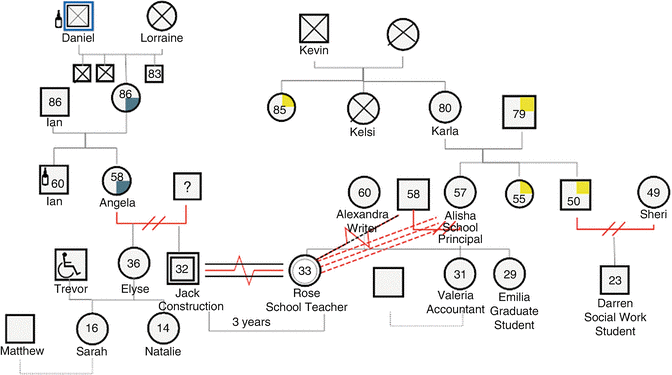
4. Medical Genogram
Medical Genograms are by far the most widely used genograms. It is mainly because they are quite helpful in identifying diseases in the family the carriers of certain genes, especially sex-linked diseases. The symbols for medical genograms are equally extensive. It covers all the important information relating to multiple types of diseases and even lifespan.
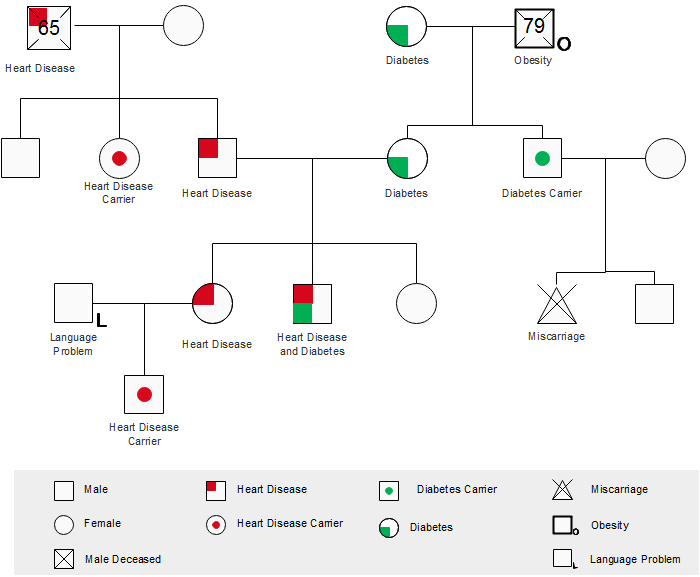
Part 5: Common Symbols Used in Genogram
As there are multiple genograms, each of these genograms uses its specific symbols to highlight the important information. Let’s go through some of these symbols and see what they mean:
1. Basic Symbols
In a general genogram, there is nothing complex but a simple mapping out of everyone in the family. There are multiple symbols to represent gender, age, lifespan, and if they are alive or not. A square represents a male while a circle represents a female. To show a person's lifespan, a number is written in the middle with four diagonal lines pointing towards it. The following picture covers most of the commonly used genogram symbols.
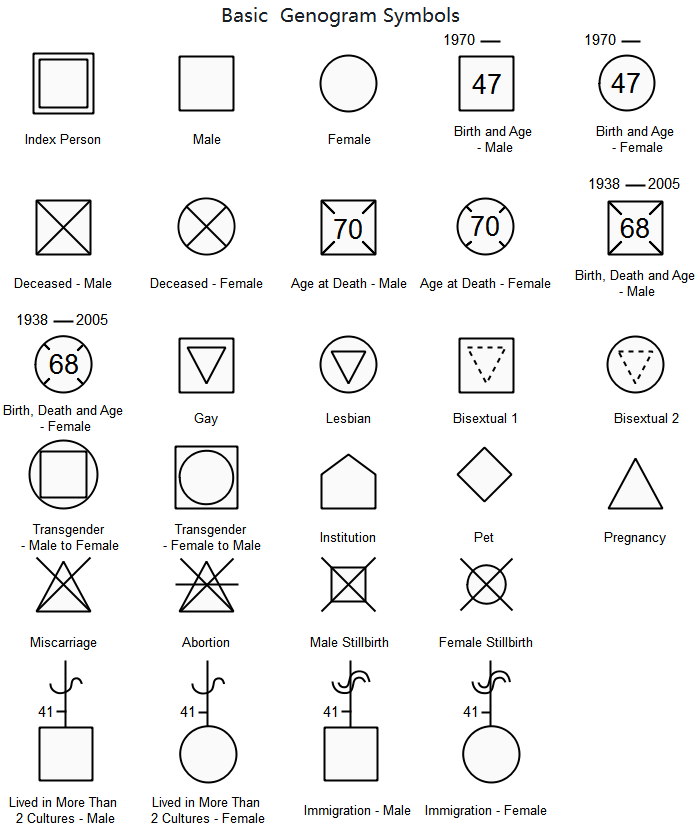
2. Medical Genogram Symbols
For a Medical genogram, you might need symbols that are appropriate to the diseases. For heart disease, a red quarter on the top right is used, while for diabetes, a green bottom quarter and cancer are colored in violet. Along with these, multiple other diseases are there are multiple other diseases that are represented through colors and orientation of the color in the shape as shown in the diagram below.
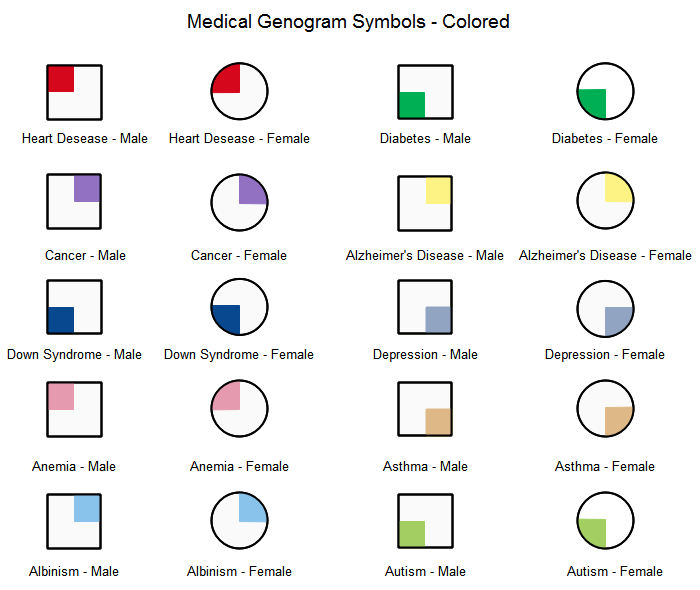
3. Relationship Genogram
A relationship genogram has less to do with symbols and more to do with the style of the lines. The style is changed from a solid line to dashed and dotted to distinguish between multiple relationships. Some of the ways to represent relationships in a genogram are given below:
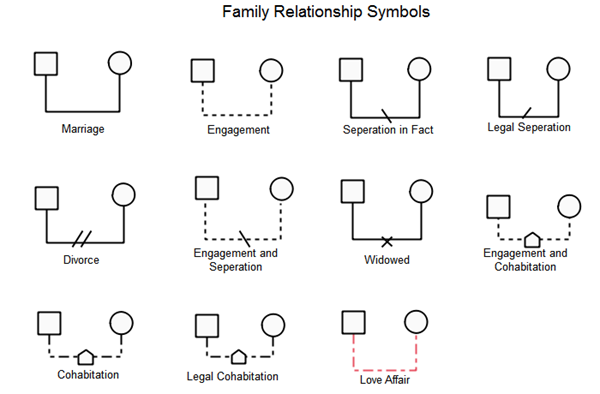
4. Emotional Genogram
There is no doubt that there are an unlimited amount of ways that one can feel about a single relationship. However, to give it a simpler touch, these genogram symbols identify the feelings between individuals and deem the emotional relationship as close, friendly, hostile, or abusive. The following genogram symbols cover a lot of other ways to label the emotions in a relationship:

Part 6: How to Create and Use Genograms?
Step 1: Select the Type of Genogram
To create a genogram, first, decide the type of genogram you want to make. You can choose between an emotional relationship or a medical genogram. If you don't want to start too complex, you can try to make a simple genogram.
Step 2: Collect Data
Next, you need to collect all the data needed to create a genogram. If you are making a medical one, get to know everyone’s medical history and make notes. For relationship or emotional genograms, you can talk to everyone separately to collect data.
Step 3: Draw the Symbols
Once you have collected data and decided on the genogram you want to make, next filter through the symbols you will need. Select appropriate symbols depending on gender, age, and status. Draw the appropriate symbols keeping in mind that the make ones are always on the left side.
Step 4: Link the Symbols
Link the symbols with appropriate lines discussing their marital status, emotional status, and more. The solid or stylized lines are self-explanatory, but you can add descriptive lines to show what they mean. You can even add a key at the bottom for a layperson to understand the symbols of the genogram.
EdrawMax
All-in-One Diagram Software
- Superior file compatibility: Import and export drawings to various file formats, such as Visio
- Cross-platform supported (Windows, Mac, Linux, Web, Android, iOS)
Part 7: Genogram vs. Family Tree
A genogram is structurally similar to a family tree, but other than that, there is nothing in common between the two. While a family tree only covers how the members are related to each other and might even use the photographs to identify individuals, a genogram is different. A genogram uses symbols to show members of the family and identify the relationships between them. Describing the emotional factor and the medical well-being of the family members, it is a detailed chart covering all sorts of information.
Part 8: Examples of Genograms
Now that you know how to create your genogram, here are a few examples to inspire you. They will help get your creative juices flowing and give you an idea about designing and arranging your genogram.
Luke Skywalker Genogram
If you are a fan of Star Wars, this genogram will surely impress you. This Luke Skywalker genogram explores the relationship between all the main characters of the story. If you want to give someone a quick rundown about how all of them feel about each other, this genogram is your go-to visual tool.
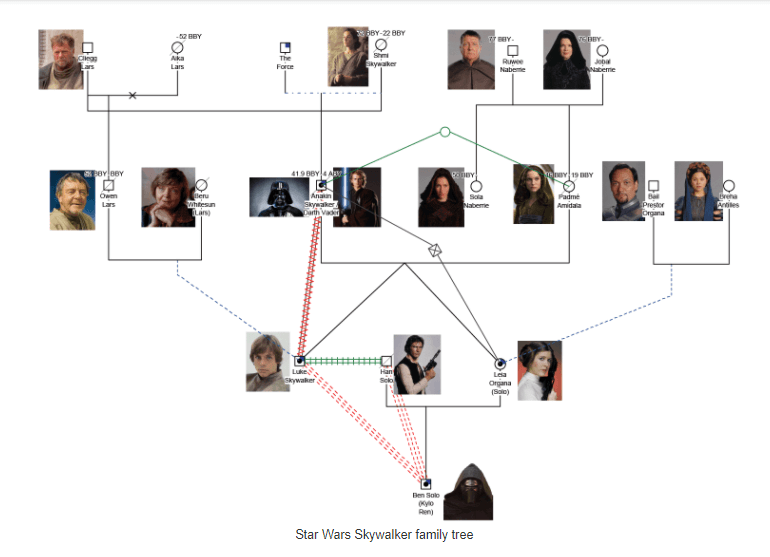
Down syndrome Genogram
This down syndrome genogram shows how the gene is transferred between generations from carrier males and females. The three generations of individuals show affected members, carriers as well as normal members.
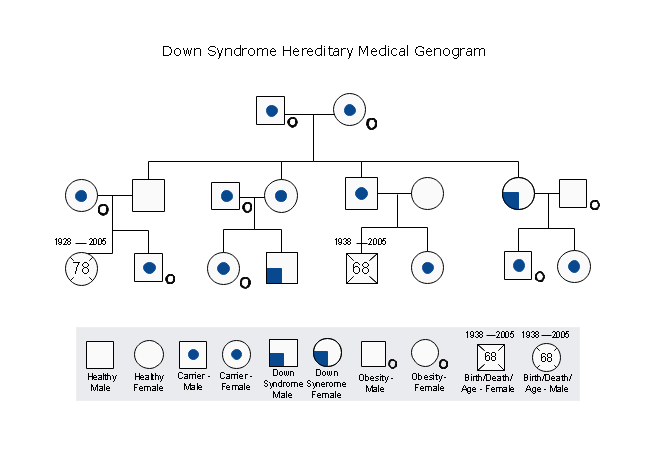
Further Reading:
Free Download Editable Genogram Examples
Part 9: Conclusion
In all truth genogram is a great tool for representing family trees with a lot more information. Hopefully, this article will help you understand how to read genograms and also create them. Try to create your genogram to get started, and you will soon understand that genograms are not only useful for clinical purposes but can also help your family come closer.



